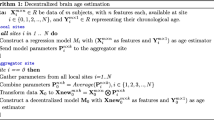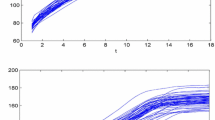Abstract
It has been a popular trend to decode individuals’ demographic and cognitive variables based on MRI. Features extracted from MRI data are usually of high dimensionality, and dimensionality reduction (DR) is an effective way to deal with these high-dimensional features. Despite many supervised DR techniques for classification purposes, there is still a lack of supervised DR techniques for regression purposes. In this study, we advanced a novel supervised DR technique for regression purposes, namely, supervised multidimensional scaling (SMDS). The implementation of SMDS includes two steps: (1) evaluating pairwise distances among entities based on their labels and constructing a new space through a distance-preserving projection; (2) establishing an explicit linear relationship between the feature space and the new space. Based on this linear relationship, DR for test entities can be performed. We evaluated the performance of SMDS first on a synthetic dataset, and the results indicate that (1) SMDS is relatively robust to Gaussian noise existing in the features and labels; (2) the dimensionality of the new space exerts negligible influences upon SMDS; and (3) when the sample size is small, the performance of SMDS deteriorates with the increase of feature dimension. When applied to features extracted from resting state fMRI data for individual age predictions, SMDS was observed to outperform classic DR techniques, including principal component analysis, locally linear embedding and multidimensional scaling (MDS). Hopefully, SMDS can be widely used in studies on MRI-based predictions. Furthermore, novel supervised DR techniques for regression purposes can easily be developed by replacing MDS with other nonlinear DR techniques.








Similar content being viewed by others
References
Acha, B., Serrano, C., Fondon, I., & Gomez-Cia, T. (2013). Burn depth analysis using multidimensional scaling applied to psychophysical experiment data. IEEE Trans Med Imaging, 32(6), 1111–1120.
Biswas, S., Bowyer, K.W., Flynn, P.J. (2010). Multidimensional scaling for matching low-resolution facial images. 2010 Fourth IEEE International Conference on Biometrics: Theory, Applications and Systems (BTAS), 1–6.
Biswas, S., Bowyer, K. W., & Flynn, P. J. (2012). Multidimensional scaling for matching low-resolution face images. IEEE Transactions on Pattern Analysis and Machine Intelligence, 34(10), 2019–2030.
Cao, P., Liu, X., Yang, J., Zhao, D., Huang, M., Zhang, J., & Zaiane, O. (2017). Nonlinearity-aware based dimensionality reduction and over-sampling for AD/MCI classification from MRI measures. Computers in Biology and Medicine, 91(1), 21–37.
Chen, H. T., Chang, H. W., & Liu, T. L. (2005). Local discriminant embedding and its variants. 2005 IEEE Computer Society Conference on Computer Vision and Pattern Recognition, 2, 846–853.
Cox, T. F., & Cox, M. A. A. (2001). Multidimensional scaling. Journal of the Royal Statistical Society, 46(2), 1050–1057.
Dosenbach, N. U., Nardos, B., Cohen, A. L., Fair, D. A., Power, J. D., Church, J. A., et al. (2010). Prediction of individual brain maturity using fMRI. Science, 329(5997), 1358–1361.
Forero, P. A., & Giannakis, G. B. (2012). Sparsity-exploiting robust multidimensional scaling. IEEE Transactions on Signal Processing, 60(8), 4118–4134.
Franke, K., Luders, E., May, A., Wilke, M., & Gaser, C. (2012). Brain maturation: Predicting individual BrainAGE in children and adolescents using structural MRI. NeuroImage, 63(3), 1305–1312.
Geng, X., Zhan, D. C., & Zhou, Z. H. (2005). Supervised nonlinear dimensionality reduction for visualization and classification. IEEE Transactions on Systems, Man, and Cybernetics, Part B (Cybernetics), 35(6), 1098–1107.
Jenkinson, M., Beckmann, C. F., Behrens, T. E., Woolrich, M. W., & Smith, S. M. (2012). FSL. NeuroImage, 62(2), 782–790.
Kokiopoulou, E., & Saad, Y. (2007). Orthogonal neighborhood preserving projections: A projection-based dimensionality reduction technique. IEEE Transactions on Pattern Analysis and Machine Intelligence, 29(12), 2143–2156.
Liu, M., Zhang, D., & Shen, D. (2016). Relationship induced multi-template learning for diagnosis of Alzheimer’s disease and mild cognitive impairment. IEEE Transactions on Medical Imaging, 35(6), 1463–1474.
Liu, X., Cao, P., Wang, J., Kong, J., & Zhao, D. (2019). Fused group lasso regularized multi-task feature learning and its application to the cognitive performance prediction of Alzheimer’s disease. Neuroinformatics, 17(2), 271–294.
Maaten, L. V. D., & Hinton, G. (2008). Visualizing data using t-SNE. Journal of Machine Learning Research, 9(11), 2579–2605.
Xia, M., Wang, J., & He, Y. (2013). BrainNet viewer: A network visualization tool for human brain connectomics. PLoS One, 8(7), e68910.
MouraO-Miranda, J., Bokde, A. L. W., Born, C., Hampel, H., & Stetter, M. (2005). Classifying brain states and determining the discriminating activation patterns: Support vector machine on functional MRI data. NeuroImage, 28(4), 980–995.
Mwangi, B., Hasan, K. M., & Soares, J. C. (2013). Prediction of individual subject’s age across the human lifespan using diffusion tensor imaging: A machine learning approach. NeuroImage, 75(1), 58–67.
Mwangi, B., Tian, T. S., & Soares, J. C. (2014). A review of feature reduction techniques in neuroimaging. Neuroinformatics, 12(2), 229–244.
Nooner, K. B., Colcombe, S. J., Tobe, R. H., Mennes, M., Benedict, M. M., Moreno, A. L., et al. (2012). The NKI Rockland sample: A model for accelerating the pace of discovery science in psychiatry. Frontiers in Neurosciences, 6, 152. https://doi.org/10.3389/fnins.2012.00152.
Pereira, F., Mitchell, T., & Botvinick, M. (2009). Machine learning classifiers and fMRI: A tutorial overview. NeuroImage, 45(1), S199–S209.
Power, J. D., Mitra, A., Laumann, T. O., Snyder, A. Z., Schlaggar, B. L., & Petersen, S. E. (2014). Methods to detect, characterize, and remove motion artifact in resting state fMRI. NeuroImage, 84, 320–341.
Qin, J., Chen, S. G., Hu, D., Zeng, L. L., & Shen, H. (2015). Predicting individual brain maturity using dynamic functional connectivity. Neuroscience, 9(10), 418.
Roweis, S. T., & Saul, L. K. (2000). Nonlinear dimensionality reduction by locally linear embedding. Science, 290(5500), 2323–2326.
Shine, J. M., Koyejo, O., & Poldrack, R. A. (2016). Temporal metastates are associated with differential patterns of time-resolved connectivity, network topology, and attention. Proceedings of the National Academy of Sciences, 113(35), 9888–9891.
Smith, S. M., Jenkinson, M., Woolrich, M. W., Beckmann, C. F., Behrens, T. E., Johansen-Berg, H., et al. (2004). Advances in functional and structural MR image analysis and implementation as FSL. NeuroImage, 23(Suppl. 1), S208–S219.
Tenenbaum, J., De-Silva, V., & Langford, J. (2000). A global geometric framework for nonlinear dimensionality reduction. Science, 290(5500), 2319–2323.
Tian, L., Ma, L., & Wang, L. (2016). Alterations of functional connectivities from early to middle adulthood: Clues from multivariate pattern analysis of resting-state fMRI data. NeuroImage, 129, 389–400.
Yoo, K., Rosenberg, M. D., Hsu, W. T., Zhang, S., Li, C. R., Scheinost, D., et al. (2018). Connectome-based predictive modeling of attention: Comparing different functional connectivity features and prediction methods across datasets. NeuroImage, 167, 11–22.
Zhang, C., Dougherty, C. C., Baum, S. A., White, T., & Michael, A. M. (2018). Functional connectivity predicts gender: Evidence for gender differences in resting brain connectivity. Hum Brain Mapping, 39(4), 1765–1776.
Zhang, S. Q. (2009). Enhanced supervised locally linear embedding. Pattern Recognition Letters, 30(13), 1208–1218.
Acknowledgments
This work was supported by the National Natural Science Foundation of China (Grant Nos. 61773048 and 61272356) and National Key R&D Project (2017YFC1703506).
Author information
Authors and Affiliations
Corresponding author
Ethics declarations
Conflict of Interests
The authors declare no conflict of interest.
Additional information
Publisher’s Note
Springer Nature remains neutral with regard to jurisdictional claims in published maps and institutional affiliations.
Electronic supplementary material
ESM 1
(PDF 1047 kb)
Rights and permissions
About this article
Cite this article
Cao, X., Chen, C. & Tian, L. Supervised Multidimensional Scaling and its Application in MRI-Based Individual Age Predictions. Neuroinform 19, 219–231 (2021). https://doi.org/10.1007/s12021-020-09476-6
Published:
Issue Date:
DOI: https://doi.org/10.1007/s12021-020-09476-6




